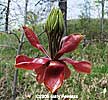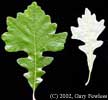
Introduction to Tree and Shrub Identification
         |
Plants are generally much more variable in form from one individual to the next than is true of animals. Individual plants can't migrate to a warmer climate when winter comes, move to a better source of water if it gets too dry, or move into the sun if they are shaded. Instead they must adapt to the existing conditions wherever they are. As a consequence most plants have developed various means of adapting to the conditions by varying their form. For example, it is well known that trees grown in full sun are often much broader of canopy than is true for the same species grown in shade. They must also adapt to damage of their growing tips by animals and various other natural phenomena. Because they tend to be long-lived they may also exhibit dramatic variation in certain characters, such as bark, at different stages in their life history. If we are to learn to recognize the species of trees in their diverse forms we must learn to recognize reliable character differences between similar species, and to understand the range of variablity within each species. The mechanism most often employed for learning these characters is a "dichotomous key" based on a set of diagnostic characteristics that have been confirmed by use over a wide area and a large number of individuals. A dichotomous key may be thought of as a word tool in which the user is presented with two exclusive alternatives (e.g. leaves opposite or alternate) and chooses the alternative that best fits the plant in question. That choice leads to another set of two alternatives from which the best choice is accepted, and so on, until the user reaches an answer. With practice, as the user learns to understand the terms, it becomes easier to quickly narrow the possibilities to a small subset of species, within which a few critical characters can be examined to conclude the identification. A simple example from the following key illustrates the process. We examine a particular tree in question and the key leads us through the steps, 1. broad leaves, 2. leaves compound, 3. leaves opposite, 4. each leaf with three leaflets. If we have interpreted the characters properly, we will arrive at the answer, Staphylea trifolia, the bladdernut tree. Of course many species will require more steps and perhaps more difficult choices, but the process is the same. The species of plants are often best distinguished by the characters of their flowers and fruits, primarily because those characters are the most consistent and dependable. The use of characters based on flowers and fruits can make the job of identification much easier, but they are typically present for only a brief period and may be resticted to the upper portions of the tree, beyond the reach of the botanist. In order to make this key functional over a longer portion of the year it is based mainly on vegetative characters, especially those of the leaves and twigs. A separate key based on flowers may be added later. The following discussion introduces the basic concepts and terms that are used to identify trees. A good starting point is to determine whether the leaves are simple or compound and if their attachment to the twigs is opposite or alternate. Simple leaves have one undivided (though sometimes lobed) blade. Compound leaves have the blade fully divided into several "leaflets". Each point along the twig at which one or more leaves is attached is called a node. Opposite leaves, as the name suggests, are attached oppposite one another on opposite sides of the twig resulting in two leaves at each node. Alternate leaves produce only one leaf at each node on the twig, usually alternating sides or arranged in a long spiral pattern along the twig. One of the easiest characters to recognize is the presence of thorns or other forms of armament. These structures range from narrow, flexible "prickles" to short, stiff, broad-based thorns, to long, branched thorns and may arise in many intermediate forms. They may be scattered widely over the surface of the stems or arranged in specific patterns as single, paired or even trebled structures at the nodes. In addition, each species may have specific characters related to the hairiness or pubescence of the leaves, bark or buds, or to other coverings such as scales. Even after the leaves have fallen, we can still easily determine how the leaves were attached to the stem. After a leaf falls, a leaf scar remains on the twig at the point at which each leaf was attached. Leaves that were opposite will leave behind opposite leaf scars and leaves that were alternate will leave alternate leaf scars. Within each leaf scar there are one or more bundle scars, each representing a cross-section of vascular bundles that ran from the branch into the petiole when the leaf was attached. The number, shape and pattern of bundle scars can be used to help identify some species. Above each leaf scar there is a bud.
Buds are one of the most important characters for identification of
woody species. They form during the summer and autumn and persist until
the next spring, providing dependable key characters over a long period
of time. These so-called "winter buds" contain the small beginnings
of the next season's leaves and a meristem region which will continue
to permit cell division and potential growth of the branches. For many species each bud has one or more protective external bud scales varying among species in size, number, shape, color, pubescence and arrangement. A few species lack the outer protective scales and the small developing leaves are therefore visible in these "naked" buds. Buds which terminate a twig are defined as terminal buds or end buds. Buds developed along the side of a twig are known as axillary buds or lateral buds. In some species a true terminal bud does not form at the end of the twig. The axillary bud nearest the end of the twig becomes the end bud by default. This false end bud can be recognized by a growth of the twig beyond the bud's base. It can be difficult to discern the difference between true and false end buds until the character is fully understood, and it may require a good hand lens to observe clearly for some species. However, it is often a critical character for identification of tree and shrub species and should not be ignored. The tissues which will become next season's flowers are included in the same buds as the leaves for some species, and in others they are borne in separate flower buds--often of a different appearance. The flowers of some trees are aggregated in conspicuous structures called aments or catkins appearing much like large buds. They are actually a very compact inflorescence consisting of many reduced, unisexual flowers borne close together on a common axis, with subtending scales. Another subtle, but very important character in identification of trees and shrubs is the presence or absence of stipules. Stipules are green, leaf-like, (often small) structures, attached to the twigs in pairs, one at each side of each petiole. In some species they may fall off early in the growing season and in others they may persist essentially throughout the growing season. In either case they leave behind distinctive, though often very small, stipule scars on the twig that may provide important key characters. During the first year of a tree's life a region known as the pith forms in the center of the twigs. Subsequent growth in the diameter of the twig is accomplished via the addition of new cells produced toward the outer regions of the twigs, leaving the pith as the central region of the twig throughout the tree's life. Identification of species may be aided in some cases by recognition of characteristics of the pith, including color, structure and cross-sectional shape. |